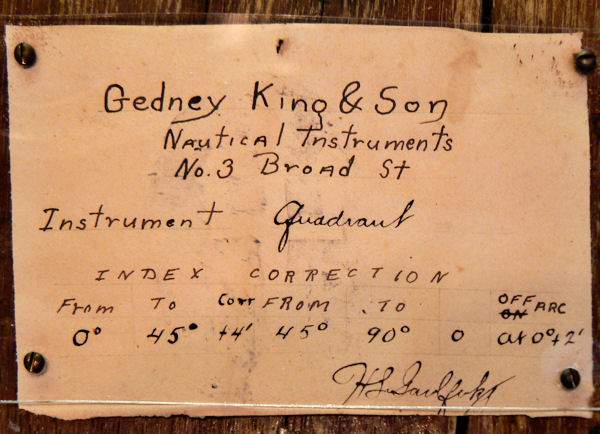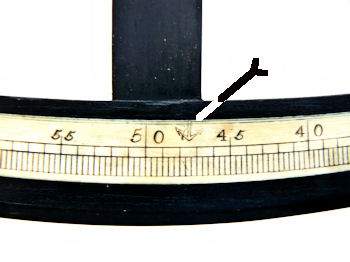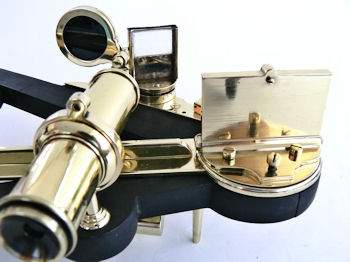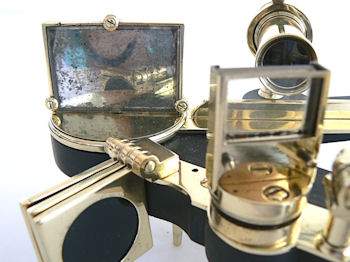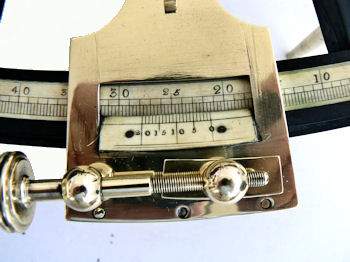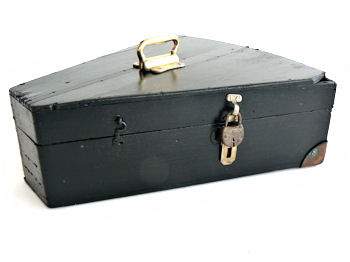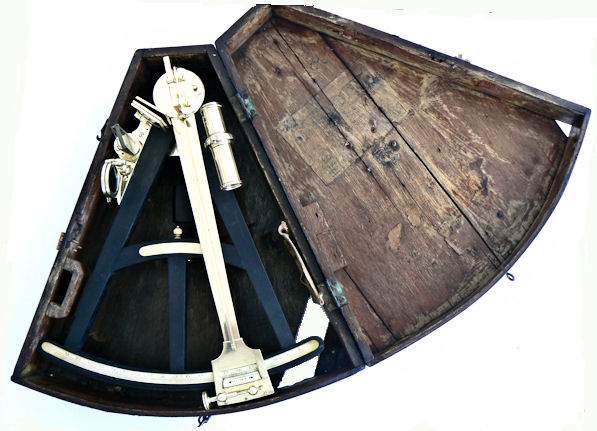ANCHOR IMPRINT
& TELESCOPE Ca 1780
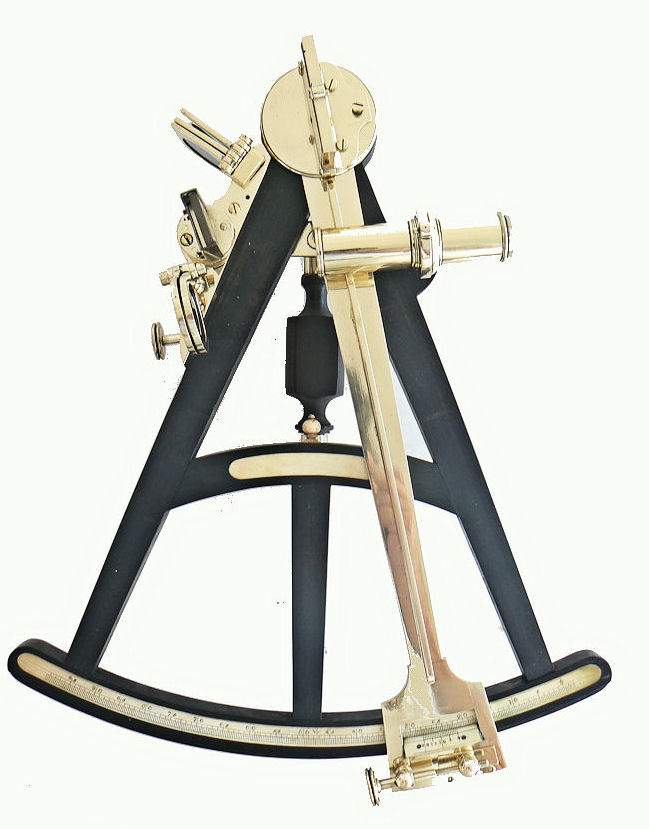
PRESENTED is a mariner’s octant fitted
with a telescope and a handsome handle which is a rare embellishment on octants of this design and period. It has an
imprint of a partial anchor on the arc between 45°; and 50° and likely dates to the last half of the 18th C. The
most famous maker to use this mark was Jesse Ramsden. It was Ramsden who invented the dividing machine which allowed
for the precision marking of degrees on an instrument’s arc in 1775.This instrument is smaller, but still oversize version
of the Hadley octant in which the “double reflecting” principal was introduced by Hadley to the Royal Society in
London in 1731. Hadley began selling octants shortly thereafter which had a vertical dimension of 17″ or more. The
instrument here is 14 inches on the vertical. It has recently been polished and lacquered, and is in a remarkable
well preserved condition considering its 230 year age and use at sea. You may read the Condition Statement for details.
The cross member, which looks
to be original ivory is unmarked. This is not unusual as many instruments were made for the retailer or
an owner to imprint their name which frequently was not done
LABEL AND MARKINGS:
Charles Gedney King
was the son of Gedney King II, Nautical Instrument Maker, whom he partnered with in 1832 under the firm name of Gedney King
& Son until he took over the firm in 1839 which dates the inspection certificate and in turn the octant to these dates.
The firm was housed at 7 Broad St., Boston as of this date, and continued in business until 1858. It is rare to find an instrument
with a certificate of inspection which makes this an important relic.
ANCHOR MARK: You can
clearly see the flukes of an anchor between 45° and 50° position on the arc. The anchor mark is best known
as that of Jessie Ramsden, but others have used it. Ramsden is the English instrument maker who invented the dividing
machine which allowed for the precision indexing of degrees on an instrument’s arc.
certificate of inspection Ca 1839JESSE RAMSDEN, ONE OF ENGLAND’S
MOST IMPORTANT INSTRUMENT MAKER’S HISTORY: Jesse Ramsden (1735-1800)Ramsden was one of the most famous English scientific-instrument makers of the second half of the eighteenth century. In
1775, he invented a semi-automatic dividing machine, capable of marking graduated scales on sextants and other nautical and
astronomical instruments for his own instruments and provided the same to other mathematical instrument makers. He developed
improvements in the manufacture of sextants, theodolites, barometers, micrometers, and countless other devices. One of the
most important instruments built by him is the great astronomical circle of the Palermo Observatory. In 1786, elected fellow
of the Royal Society of London and, eight years later, member of the Imperial Academy of Saint Petersburg. In 1795, won the
Copley Medal, the highest scientific award of his time: the prize was established in 1736 by the Royal Society, thanks to
a bequest from Sir Godfrey Copley.
Arc engraver’s mark between 50° & 45°
The accuracy and sharpness of the arc’s numerals
suggest that this instrument was made by an advanced instrument maker, one who would stand at the top of his trade.
The frame has features that are very advanced for the instruments age.
For details on how we dated this instrument, see below.
|
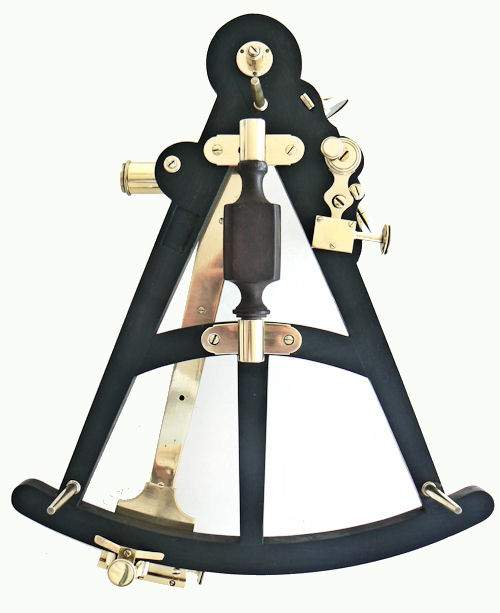 |
All
in all, a rare, desirable, and special example of a late Hadley style octant.
DIMENSIONS:
- Arc reads – 5 to +95 degrees
- Length of index arm 14″ long
- Width of frame at arc 11 1/2 ” wide
- Index mirror 45 x 32 mm
- Horizon mirror – 25 x 21 mm
- Five shade glasses
- Telescope
- Weight 2 Lbs 14 oz
 OUR QUALIFICATIONS: We are one of the few company’s still selling navigation
OUR QUALIFICATIONS: We are one of the few company’s still selling navigationinstruments that know anything about them. For purposes of judging whether Joel’s opinion counts, he was the editor
of the chapter on sextants of the 1977 Edition of “Bowditch”, The American Practical Navigator, NAVPUB 9; a member of the
U.S. Naval Academy Navigation Symposium Board, 1975 -1978; the author of a book on marine sextants, Cornell Maritime Press,1975,
and the founding president of Nautech Maritime Corporation which partnered with Tamaya of Japan in the introduction of the
MS 733 Spica, the MS 833, Jupiter, MS 933 Venus sextants and the famous NC-2 navigation computer, in the U.S. market. Joel
is also a retired Master Mariner, and held a U.S. Navy “D” Qualification as a Senior Skipper – Oceans. From 1995 through 2000, he
served as a Varsity Offshore Sailing Team coach at the U.S. Naval Academy.
